13 Nov 2013
Why Is Drug Use Surging In Baby Boomers?
Statistics gathered by the Substance Abuse and Mental Health Services Administration, or SAMHSA, show a disturbing trend among older Americans. Members of the Baby Boom generation are using drugs and getting addicted to them in record numbers. Whether we can explain the trend or not, the fact remains that elder drug abuse presents some unique problems that require unique approaches for prevention and treatment.
 The statistics from SAMHSA show that among older Americans in recent years, marijuana use has increased five-fold, cocaine use has quadrupled, heroin abuse has doubled, and abuse of prescription drugs has more than quadrupled. The survey from SAMHSA also records treatment for drug abuse and addiction and found increases in the numbers of Boomers getting help for alcohol abuse in combination with cocaine use, and for abusing prescription painkillers. Emergency room visits for painkiller abuse and overdoses increased greatly over the last decade.
The statistics from SAMHSA show that among older Americans in recent years, marijuana use has increased five-fold, cocaine use has quadrupled, heroin abuse has doubled, and abuse of prescription drugs has more than quadrupled. The survey from SAMHSA also records treatment for drug abuse and addiction and found increases in the numbers of Boomers getting help for alcohol abuse in combination with cocaine use, and for abusing prescription painkillers. Emergency room visits for painkiller abuse and overdoses increased greatly over the last decade.
Explanations And Complications Of Drug Abuse In Older Americans
At first glance, the statistics surrounding the use and abuse of drugs in older Americans seems surprising. However, it is important to understand that we are discussing a generation of people who came of age in the 1960s, a time of experimentation and rebellion against authority. In tracking the drug and alcohol behaviors of this generation over the years, finding that they now, in their older years, are still using drugs is not a surprise. It only seems shocking when compared with the generations that came before them.
Unfortunately, drug abuse is even more of a problem for a person in his 50s and 60s than it was when he was in his 20s. As we age, our metabolism slows. For an older person abusing drugs or drinking too much alcohol, the time it takes to metabolize and get out of his system is much longer. An older person using may be intoxicated for longer and, therefore, at risk for more accidents and injuries.
Another issue is that drug users in their 50s or 60s are more likely to have health problems than they did in their younger years. Drug or alcohol abuse may exacerbate these problems, or even interact badly with prescribed medications. Furthermore, the symptoms of these other health conditions may mask the usual signs of drug abuse or addiction.
Signs Of Drug Abuse
Drug abuse and addiction are serious problems at any age, but in older Americans they present greater risks and complications. It is important to be aware of the possibility of drug use and to look out for signs in loved ones. Because another health problem may cause symptoms that mask the physical signs of drug abuse, watch for changes in behavior as the sign of a problem. Mood swings that are unexplained could be a sign of addiction, drinking or drug abuse. Changes in personality are also troubling. When someone just doesn’t seem like himself anymore, there could be a problem with drug abuse.
Prescription abuse is a growing problem among all age groups, so look for signs that your older friend or family member is abusing them. This could mean that he is requesting more refills for painkillers, seeing several doctors to get more prescriptions, going to more than one pharmacy or in other ways is trying to get more of his medications than has been prescribed.
Getting Help For A Loved One Abusing Drugs Or Alcohol
If anyone you love or care about is abusing drugs or alcohol, it is important to help him seek treatment; with an older person, it is especially imperative. Drug abuse can cause even more problems for someone who is older and should be stopped in its tracks. Having the courage to confront your parent, spouse, or other loved one about your suspicions could just save his life.
Confrontation is never easy so be prepared. Bring one or two other people along, friends or family members your loved one trusts. Be ready with solutions so that you are not simply accusing, but helping. Do your research ahead of time and find facilities for treatment that are prepared to work with older patients. As the problem of drug abuse continues to rise in the older demographic, more treatment centers are focusing on the age group. You should be able to find treatment plans that will suit the specific needs of your loved one and that will help him feel comfortable while getting well.
11 Nov 2013
Meth Addiction And The Effects In Teens
Fans of the hit crime drama Breaking Bad may have become familiar with the dangers of methamphetamine use. However, as a parent, you may have questions about methamphetamine abuse in teenagers and whether it requires drug rehab treatment. Surveys suggest that 2 to 3.5% of adolescents have used methamphetamines [1]. Also called “speed” or “glass”, it’s a highly addictive stimulant.
How Meth Works
Methamphetamine – or “meth” for short – is a type of amphetamine, a drug that acts on the body’s central nervous system. The drug works by increasing dopamine levels within the brain to very high levels. Dopamine is the brain chemical that’s linked to pleasure, reward, motivation, and also motor function. When dopamine levels skyrocket, as they do during meth use, the user experiences a pleasurable rush that is often compared to euphoria.
While there are several types of amphetamines, meth is generally considered the most potent. The drug can be snorted, injected, or taken orally. Some abusers use a method called parachuting, which involves crushing a pill and then rolling the powder into a piece of tissue or toilet paper. The entire package – tissue and all – is then swallowed, delivering what’s believed to be a stronger, faster high because the pill’s outer protective layer has been destroyed.
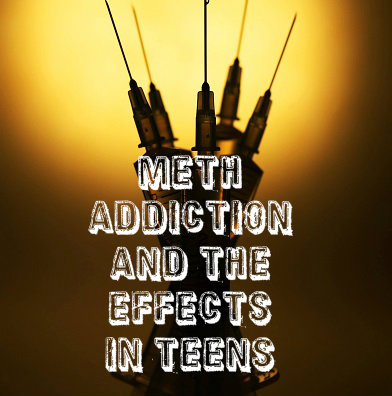 Teen meth addicts will typically use daily or nearly daily. Addiction requiring drug rehab treatment can develop quickly, sometimes within just a few uses. Chronic abuse of the drug leads to tolerance. As one’s tolerance level increases so does the amount of the drug that’s needed in order to achieve the euphoric high.
Teen meth addicts will typically use daily or nearly daily. Addiction requiring drug rehab treatment can develop quickly, sometimes within just a few uses. Chronic abuse of the drug leads to tolerance. As one’s tolerance level increases so does the amount of the drug that’s needed in order to achieve the euphoric high.
Effects Of Meth
Since meth is a stimulant, like cocaine, a teen will experience immediate physical effects, even when the drug is taken in small amounts. Meth users experience increased heart rate and respiration, irregular heartbeat, high body temperature, decreased appetite, inability to sleep, and increased physical activity.
An adolescent with a long-term meth addiction can experience more serious effects. Anxiety, confusion, and extreme weight loss are common. Many develop severe dental problems, such as tooth decay and loss, because the drug reduces output of saliva, which normally protects the mouth, and drug users often have poor dental hygiene.
Teen meth addicts are also at risk because the drug enhances the sex drive. Several studies have found that youth, especially females, who use meth are more likely to engage in risky sexual behaviors [2]. This potentially leads to unsafe sexual practices, including having sex without protection. Research has found a strong association between meth users and sexual risk-taking. A study of adults using meth found they were 1.7 times more likely to have gonorrhea and twice as likely to have chlamydia [3].
Chronic methamphetamine abusers might experience serious psychotic symptoms, including hallucinations, delusions, or paranoia. This can lead to physical problems as well. For instance, a meth user might scratch and gouge at their skin to remove “bugs.” Auditory hallucinations can be particularly dangerous if the addict believes “voices” are commanding him or her to harm others, a symptom that makes drug rehab treatment that much more important.
Meth use in teens can also cause permanent brain damage. Research shows that chronic use causes structural and functional changes to brain areas linked to memory and mood [4, 5]. In addition, brain imaging has shown that meth use changes the dopamine system in a way that reduces verbal learning and motor skills [6]. Using the drug over time also disrupts the body’s normal production of dopamine; as a result, chronic users show severe mood swings.
Signs Of Meth Abuse In Teens
- Euphoric moods (may appear unusually happy)
- Paranoia
- Reduced appetite
- Incessant talking
- Rapid weight loss
- Dilated pupils
- Dry, itchy skin
- Skin sores
- Intense mood swings
- Anxiety, nervousness
- Shaky hands
- Violent or aggressive behavior
- Excessive sweating
Symptoms can become worse as a teen’s meth addiction deepens. For instance, a meth addict often appears undernourished or even sick. He or she may have frequent mood swings, abruptly switching from chatty and friendly one moment to aggressive and hostile the next.
Treatment For Meth Addiction
Due to the serious short-term and long-term health risks, including brain damage and even death, meth addiction in adolescents requires immediate drug rehab treatment. Meth abusers can experience intense withdrawal symptoms, including severe agitation, anxiety, sleeplessness, and strong urges to use. Since withdrawal symptoms can be so powerful, teens should detox in a treatment center where they can be medically monitored.
After the drug is out of the body, your teen will start a treatment plan that will likely have several components based on his or her needs. Currently, there are no approved medications to treat methamphetamine addiction. However, rehab centers have a number of therapies for helping adolescents recover. For example, an addictions specialist may recommend cognitive behavioral therapy. This particular type of therapy helps teens learn more about the factors, such as negative emotions, irrational thoughts, or unhealthy behaviors, that contribute to their drug use. This therapy also teaches them how to deal with those factors in a drug-free way. Contingency management may also be beneficial in a drug treatment program. It provides tangible incentives, such as movie tickets or cash, for drug-free urine samples.
Alternate Therapies For Addiction
Other therapies may help your teen as well. For example, animal-assisted therapy, which involves the use of animals like dogs or horses, can be especially powerful. This treatment approach can help addicted teens reduce anxiety, build self-confidence, and develop trust. Talk with an addiction specialist to learn more about the benefits of animal-assisted therapy.
Family education and counseling will also be essential for guiding your teen through recovery. Educational sessions help parents and family members better understand the nature of addiction. They also show ways to help an addicted teen stay free of drugs. In family counseling, a therapist works with family members to pinpoint and resolve conflicts and communication issues, including those that have played a role in your teen’s decision to use drugs. Family therapy can play an important role in helping your teen avoid a relapse down the road.
Meth Affects The Brain’s Pleasure Center Long After Use
Treating an addiction to meth is challenging, in part, because the brain’s ability to produce dopamine is hampered for up to 6 months or more after drug use stops. As a result, addicts may be unable to experience pleasure. This can make it difficult for them to find enjoyment in even simple activities like spending time with friends, seeing a movie, or relaxing on the beach. This lack of positive emotion can compel many teens to start using again, just so they can feel some form of pleasure.
Yet, despite the challenges, adolescents can fully recover from a methamphetamine addiction. If you suspect or know that your teen is abusing meth, consult a drug rehab treatment as soon as possible – preferably one that is skilled in handling meth abuse and addiction in teens. The staff will work with you to lay out a plan for recovery that gives your teen the best chance for success.
Read More About What Meth Use Can Do To You
References:
[1] http://www.drugabuse.gov/drugs-abuse/methamphetamine
[2] http://www.biomedcentral.com/1471-2431/8/48/abstract
[3] http://www.healio.com/infectious-disease/hiv-aids/news/print/infectious-disease-news/%7B458a3b28-01a8-45ca-af13-dead2d781f8b%7D/methamphetamine-use-increases-risk-of-acquiring-hiv-stds-and-mrsa
[4] http://www.jneurosci.org/content/24/26/6028.long
[5] http://www.ncbi.nlm.nih.gov/pubmed/14706946
[6] http://www.ncbi.nlm.nih.gov/pubmed/11229977
Marijuana is a plant-based drug known for its potential to produce physical/mental dependence and other significant health issues when used repeatedly over extended periods of time. Generally speaking, health risks associated with marijuana use are linked to such factors as consumption level and the potency of any given batch of the drug. In a study published in October 2013 in the journal Addiction, a multi-institution Dutch research team sought to determine whether young adult users can accurately gauge their level of marijuana consumption or the potency of the marijuana they smoke or ingest. These researchers concluded that young adults generally do a poor job of accurately tracking their marijuana usage.
Effects And Health Consequences Of Marijuana
![]() Marijuana is the most readily available form of a plant-based drug called cannabis, which has a chief active ingredient called THC (tetrahydrocannabinol). When THC molecules enter the bloodstream, they attach themselves to nerve cells inside the brain and trigger a form of mind alteration classically associated with effects such as heightened pleasure levels, reduced body coordination and substantial changes in normal thought and perception. In controlled circumstances, marijuana use is now legal in certain jurisdictions across the U.S. However, most states still consider marijuana use illegal, and federal statutes also prohibit use of the drug.
Marijuana is the most readily available form of a plant-based drug called cannabis, which has a chief active ingredient called THC (tetrahydrocannabinol). When THC molecules enter the bloodstream, they attach themselves to nerve cells inside the brain and trigger a form of mind alteration classically associated with effects such as heightened pleasure levels, reduced body coordination and substantial changes in normal thought and perception. In controlled circumstances, marijuana use is now legal in certain jurisdictions across the U.S. However, most states still consider marijuana use illegal, and federal statutes also prohibit use of the drug.
According to the National Institute on Drug Abuse, marijuana use is associated with mental and physical health risks that include learning and memory deficits during adolescence, lowered IQ scores during adulthood, temporary heart rate increases, heartbeat irregularities, impaired judgment and decision-making, impaired memory functions, a reduced ability to control body movements, the same types of lung-related ailments that commonly affect cigarette smokers and temporary bouts of psychosis (a mental health term for hallucinations and/or delusional thinking). In addition, habitual smokers of the drug have heightened risks for developing longer-term forms of psychosis that persist over time.
Marijuana Addiction Risks
Marijuana has a relatively benign reputation when compared to other powerful, illicit or illegal substances such as amphetamine/methamphetamine, cocaine or opioid narcotics. Despite this reputation, current scientific evidence indicates that all habitual marijuana users run a considerable risk of becoming physically dependent on the drug and subsequently developing the drug-oriented personal and social behaviors classically associated with the presence of addiction. Roughly 17 percent of individuals who start marijuana use before reaching adulthood become addicted, while anywhere from one-quarter to one-half of all everyday users develop an addiction. Part of the addiction risk associated with the drug stems from a rise in marijuana potency over the last several decades. While some sources report a 3,000 percent increase in the drug’s potency in that timespan, more reliable estimates place the increase in strength at anywhere from 200 percent to 600 percent.
Marijuana Smoker’s Estimates Of Usage
In the study published in Addiction, researchers from three Dutch institutions sought to determine how accurately habitual marijuana users can track their intake of the drug. To a certain extent, accurate tracking could potentially reduce the risks for the onset of addiction by allowing users to gauge their level of involvement in drug use and curb that level when necessary. The researchers made the first part of their assessment by asking 106 young adults to estimate their level of marijuana use, as well as their level of intoxication and the relative potency of the marijuana they consumed. Next, the researchers compared the participants’ estimates to objectively verifiable measurements of these same factors.
The authors of the study found that, by objective measurement, the amount of marijuana used by an individual in any given situation varies considerably, as does the potency of any given marijuana batch. However, they also concluded, marijuana users typically do a bad to mediocre job tracking these changes in potency and amount. As a result, marijuana users tend to have only a partially reliable ability to understand and monitor their true level of marijuana use.
Significance And Conclusions Of Marijuana-Use Study
The authors of the study in Addiction did not specifically associate a limited ability to track marijuana usage with increased risks for physical dependence and addiction. However, by logical inference, people who don’t know how much marijuana they use or how strongly that marijuana affects them may fail to notice key physical and mental changes that signal the onset of dependence- and addiction-related problems. Subsequently, they may fail to take critical steps necessary to prevent the onset of dependence or addiction. The study’s authors note that young adult marijuana users don’t entirely fail to track their marijuana intake; instead, they simply track their intake too poorly to make reliable estimates.
Inhalants are a broad range of common, commercially available chemicals that get grouped together because they can function as makeshift drugs when inhaled through the nose or mouth. Use of these chemicals can trigger a number of serious or potentially fatal short- and long-term health problems. In a study published in 2013 in the journal Addiction, a team of Australian researchers assessed the prospects for eventual recovery from the nervous system-related damage associated with inhalant use. These researchers concluded that most affected individuals substantially or fully recover their nervous system health after 15 years of abstinence from inhalant intake.
Types Of Inhalants

Courtesy of: www.drugfreeworld.org
Inhalants get their name because people almost always abuse them by breathing them in, rather than by injecting them or using other means of introducing them into the body. Substances employed in this manner in the U.S. and throughout the world include aerosol-based sprays (e.g., paints, computer cleaners and deodorants), volatile solvents (e.g., glues, gasoline and degreasers), gases (e.g., nitrous oxide, butane and refrigerants) and nitrites or “poppers” (e.g., amyl nitrite and butyl nitrite).
How Inhalants Work
Other than nitrites, most inhalants achieve their mind-altering effects by interfering with the normal function of the central nervous system (spinal cord and brain) and producing an effect that mimics certain aspects of alcohol intoxication. Affected individuals may also develop problems with delusional thinking and/or hallucinations (known collectively as psychosis). According to figures compiled in 2011 by the National Institute on Drug Abuse, about 10 percent of high school-age children in the U.S. have used an inhalant at least once.
Health Problems Of Inhalant Use
Short-term health problems associated with inhalant abuse include seizures, an unusually slow or fast heartbeat, high blood pressure, muscle function impairment, increased accident rates and increased levels of participation in risky behaviors. Short-term users are also susceptible to a phenomenon called sudden sniffing death syndrome, which occurs when an inhaled substance triggers a dangerously unstable heartbeat. Long-term health problems associated with inhalant abuse include central nervous system damage (usually brain damage), lung damage, kidney damage, heart damage, liver damage, mild to severe impairment of conscious mental function, increased risks for violent outbursts and increased risks for diagnosable mental disorders such as depression or antisocial personality disorder.
Inhalant Abuse Treatment
Many inhalant users don’t seek any type of medical treatment unless their patterns of abuse lead to obvious physical problems. For this reason, inhalant abuse treatment commonly starts with short-term efforts designed to stabilize a patient and counteract the effects of the specific inhalant substance in question. After an individual receives short-term treatment, he or she typically benefits from longer-term treatment in a program specifically designed to address inhalant-related recovery issues. Such a program usually features steps that include dealing with the effects of inhalant withdrawal, acquiring the personal and social skills required to abstain from inhalant use over extended periods of time and preparing for a return to everyday life after the active phase of treatment comes to a close. Some people also need to deal with additional issues related to other forms of substance abuse or various types of mental illness.
Long-Term Abstinence From Inhalants
Previous research efforts have shown that, after roughly two years of abstinence, most people who chronically abuse inhalants gradually experience a restoration of their conscious mental function, as well as a restoration of the normal physical function in their central nervous systems. In the current study published in Addiction, researchers from five Australian institutions examined the long-term mental and physical recovery outlook after 15 years of abstinence from inhalant use. This examination included 60 adults in long-term recovery from the chronic abuse of lead-free inhalants and 17 adults in long-term recovery from the chronic abuse of inhalants that contain lead, as well as a comparison group of 27 adults with no history of inhalant use/abuse.
After reviewing their findings, the researchers concluded that, after 15 years in recovery, former chronic abusers of lead-free inhalants have mental and physical nervous system functions that are basically indistinguishable from the mental and physical functions of people with no history of inhalant use. The former chronic users of lead-containing inhalants (usually lead-containing gasoline) commonly incur brain damage related to lead exposure. As a result of this exposure, they typically experience permanent changes in their normal mental and physical function. In turn, the permanent nature of their impairment contributes to ongoing problems even after 15 years of inhalant abstinence. While some users of lead-containing inhalants see modest improvements in their central nervous system-related abilities, others see no significant improvement over time.
29 Oct 2013
What Drives Teens To Try Ecstasy?
Ecstasy is a widespread term used for MDMA or Molly, an illegal amphetamine-like drug that also has some of the properties of hallucinogenic substances. In a study published in October 2013 in the journal Addiction, a multi-institution Australian research team examined some of the main factors that drive involvement in Ecstasy use. These researchers found that the critical factors include one’s social environment, previous history of drug use and level of a mental state called psychological distress.
Effects And Details Of Ecstasy
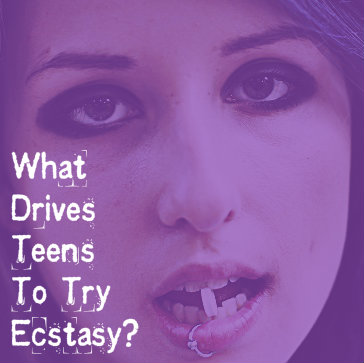 The full chemical name of Ecstasy (MDMA) is methylenedioxymethamphetamine. Outside of very limited situations, manufacturers produce this substance illegally, and distributors also usually sell it outside of legal channels. The stimulant effects of Ecstasy produce alertness and high levels of energy, while the hallucinogen-like effects of the drug produce an impaired ability to track the passing of time and unusual sensitivity to sound and touch. In addition, the drug commonly produces a benevolent mental outlook and an increased sense of social/spiritual connection with others. Ecstasy users typically view these physical and psychological changes as the drug’s desirable effects.
The full chemical name of Ecstasy (MDMA) is methylenedioxymethamphetamine. Outside of very limited situations, manufacturers produce this substance illegally, and distributors also usually sell it outside of legal channels. The stimulant effects of Ecstasy produce alertness and high levels of energy, while the hallucinogen-like effects of the drug produce an impaired ability to track the passing of time and unusual sensitivity to sound and touch. In addition, the drug commonly produces a benevolent mental outlook and an increased sense of social/spiritual connection with others. Ecstasy users typically view these physical and psychological changes as the drug’s desirable effects.
The use of Ecstasy is heavily associated with attendance at parties or dances that feature some form of electronic music; however, use can also take place in a range of other settings. The drug disrupts the body’s ability to regulate its internal temperature. In combination with the high, external body heat levels commonly found at the parties and dances where Ecstasy use occurs, this temperature dysregulation can lead to a dangerous, sometimes lethal condition called hyperthermia, which sets in when the body’s temperature rises above a sustainable level. Additional, major short-term health problems associated with Ecstasy intake include seizures and the development of significant heartbeat instability. Typically, people who take large amounts of the drug in a short span of time have the highest risks for experiencing these problems.
Psychological Distress And Ecstasy
Psychological distress is a term used to describe the presence of a range of emotional states that can undermine a person’s sense of mental well-being. Examples of these emotions include nervousness, hopelessness, restlessness and a “down” mood. By itself, psychological distress does not constitute a diagnosable mental health disorder. However, the underlying effects of a distressed psychological outlook are known contributors to the development of a number of diagnosable mental illnesses, including schizophrenia, bipolar disorder, anxiety disorders and major depression. According to figures compiled by the federal Substance Abuse and Mental Health Services Administration (SAMHSA), young adults experience psychological distress considerably more often than middle-aged adults or elderly adults, and also receive help for their condition less often than adults in these age groups.
Social Environment, Past Drug Use – Factors In Ecstasy Use
In the study published in Addiction, researchers from five Australian institutions used an assessment of 204 young adults between the ages of 19 and 23 to look at the factors that contribute to the start of participation in Ecstasy use. At the beginning of the study, none of these adults had used Ecstasy; however, over 40 percent of them had been offered the drug at some point. Six months later, the researchers identified the participants who had eventually accepted an offer to take Ecstasy and examined the reasons for this change in behavior.
After completing their assessment, the researchers concluded that factors related to an individual’s social environment played the most prominent role in the onset of Ecstasy use among the study’s young adults. Specific factors cited include having social interactions with a lot of people who already use the drug and attending the electronic music/dance events classically associated with Ecstasy use. The presence of the symptoms of psychological distress also played a meaningful role, as did a previous history of using marijuana or other forms of cannabis. However, these factors did not rise to the same level of importance as social environment.
How Study Results Can Help Ecstasy Drug Education
The authors of the study published in Addiction believe that their research can play a role in efforts aimed at curbing the use of Ecstasy and warning users about the drug’s major pitfalls. If successful, such efforts would likely have two components: a large-scale education campaign designed to reach broad segments of the population and a smaller, more targeted campaign designed to reach young adults and other individuals exposed to known risk factors for Ecstasy use.
The long-term risks for teens that abuse substances are increased likelihoods of adult addiction, developing certain cancers or heart disease and engaging in dangerous sexual behaviors that could result in contracting a sexually transmitted disease and/or an unplanned pregnancy. But there are also serious short-term risks, with the most serious being the increased likelihood of getting into a vehicular accident.
In addition, while many teens are advised not to drive a car while under the influence they may not use enough caution when considering the sobriety of another driver.
A recent study highlights the risk teens take when they drive a car or enter the car of a driver that is under the influence. Conducted by researchers at the Mailman School of Public Health at Columbia University, the study examined the risk of drug use and the risk of drug use combined with alcohol use and how such use impacted the risk of a fatal crash.
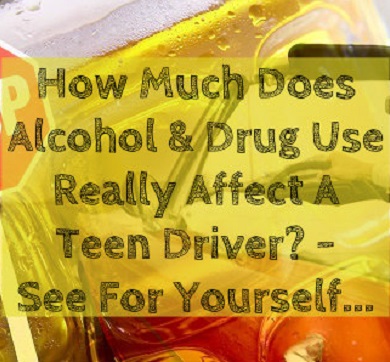
Drastic Increases In Fatal Crashes When Drugs Are Involved
The researchers found that there was a drastically increased risk of experiencing a fatal crash when drugs were involved in an accident, and this was particularly true when the drugs were used in addition to alcohol.
The study’s data was pulled from two national databases commissioned by the National Highway Traffic Safety Administration: the 2007 National Roadside Survey of Alcohol and Drug Use by Drivers and the Fatality Analysis Reporting System (FARS). FARS compiles investigation information for all vehicular crashes that resulted in a fatality within 30 days of the crash occurring on a public road.
This study is unique in its use of the two databases together to compile information about circumstances surrounding events, such as the individuals and vehicles involved.
The study, led by Guohua Li, MD, DrPH, professor of Epidemiology and director of the Center for Injury Epidemiology and Prevention, found that 31.9 percent of all drivers implicated in fatal crashes tested positive for at least one drug. Of those interviewed at roadside, 13.7 percent tested positive for at least one drug. Overall, drivers that test positive were three times more likely to be involved in a fatal car crash, with the highest risk associated with depressants followed by stimulants.
The study also showed that blood alcohol levels were increased in 57 percent of those involved in fatal crashes, while 8.8 percent of the roadside interviews had an elevated blood alcohol level. Approximately 20 percent of the fatal crash drivers tested positive for alcohol consumption and one or more additional drugs. Among the roadside interviews, 2.2 percent tested positive for alcohol and another drug.
Alcohol Increases Fatal Car Crashes By 13 Times!
The risk of involvement in a fatal car crash increased 13 times for those that tested positive for alcohol only, two times for those that were drug-positive and 23 times for drivers that were under the influence of both drugs and alcohol.
The authors of the study note that drugs may be detectable in a driver’s blood test that may not be causing impairment. In addition, the authors say that the study does not account for various levels of tolerance that may be exhibited among individual drivers, making it difficult to measure drug impairment.
Decreased Risks When Parents Talk With Their Teens
The findings highlight the importance of talking with teens about the risks of driving a vehicle while under the influence or entering a vehicle in which the driver has been using.
Parents that explain the risks and dangers can help their child make an informed decision.
When you look at the numbers, it can be discouraging to see how many teenagers continue to experiment with drugs and alcohol as this often leads to addiction. What most teens have difficulty comprehending is how this behavior could affect them for the rest of their lives.
Types Of Drugs Teens Experiment With
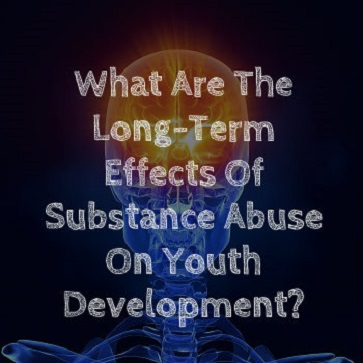 Just over one million American teenagers are addicted to illegal drugs, with another 915,000 addicted to alcohol. Even if they’re not addicted, an alarming number of teens are regularly using, with over half of high school seniors reporting having experimented with drugs and close to 30 percent having tried something other than marijuana, like heroin, cocaine, prescription drugs, inhalants, sedatives and mind-altering hallucinogens. The highest rate (19.9 percent) of illegal drug use occurs between 18 and 20 years, with the next highest rate (16.4 percent) happening between 16 and 17.
Just over one million American teenagers are addicted to illegal drugs, with another 915,000 addicted to alcohol. Even if they’re not addicted, an alarming number of teens are regularly using, with over half of high school seniors reporting having experimented with drugs and close to 30 percent having tried something other than marijuana, like heroin, cocaine, prescription drugs, inhalants, sedatives and mind-altering hallucinogens. The highest rate (19.9 percent) of illegal drug use occurs between 18 and 20 years, with the next highest rate (16.4 percent) happening between 16 and 17.
Alcohol use affects more than 10 million teens, with 5.1 million regularly binge drinking, which is defined as downing more than four or five drinks during a single sitting. Not far behind is inhalant abuse, with 25 percent of all teens 10- to 17-years-old saying they have friends who inhale dangerous fumes from things like paint, computer cleaner or glue.
Teen Drug Use Can Have Negative Effects For Years To Come
Unfortunately, the bad choices made in youth can haunt for years to come. The brain undergoes vital development during adolescence. Not since infancy has their brain been changing and forming with such rapidity.
Drug use can disturb the proper development of the prefrontal cortex in the brain. This area of the brain is responsible for important functions like organization, risk assessment, impulse control, consequence prediction and planning. But the limbic system, corpus callosum, hippocampus and cerebellum are all still forming and vulnerable to the changes wrought by drugs. Functions like emotional control, goal-setting and memory/recall are all still developing, and drug use could cause permanent problems in these areas.
Studies have repeatedly shown that heavy marijuana use damages key brain functions for years, with some researchers believing the changes are permanent. Processes like critical thinking, planning and complex attention are all shown to be diminished by heavy marijuana use. Girls seem to experience longer-lasting ill-effects, but both females and males show problems with myelin sheath formation, which affects brain signaling.
MDMA, which also goes by Molly and ecstasy, is associated with sensations of euphoria and social bonding, which is why it’s popular with young people attending large group gatherings such as concerts and dance clubs. Ironically, lowered serotonin levels as long as seven years have been observed in laboratory animals after they’ve been given MDMA, with serotonin closely associated with emotional happiness.
Alcohol causes harm to adolescent brains as well, especially binge drinking. Heavy drinking in teens has been shown to lower their ability to problem solve and understand spatial relationships, as well as memory and vocabulary impairment. And just like drugs, alcohol affects the limbic system, meaning emotional well-being is disrupted. In fact, there appears to be a connection between drinking and behavioral problems due to a lack of emotional control — researchers just aren’t sure which problem came first.
Using drugs and alcohol during adolescence can have serious and long-lasting results, with neurological development issues, impaired social development and addiction. And all of these problems can easily follow teens into adulthood.
Read More About The Effects Of Teen Substance Abuse On Families
Teens that begin using alcohol and other substances during adolescence are engaging in what experts call early initiation, which is a concern because individuals that begin using substances recreationally in high school may go on to develop a dependence by the time they reach adulthood.
There are deterrents in place to prevent teens from using alcohol and cigarettes; including age limits and heavy consequences if a business is caught selling to minors or an individual is caught purchasing for them.
A new study conducted by the Centre for Addiction and Mental Health (CAMH) finds that the majority of teens in Ontario, Canada, obtain these products from friends or family.
The researchers surveyed teens in grades 7 to 12. Among the students that smoked cigarettes, 58 percent report obtaining their last cigarette from a friend or family member. 19 percent of teen smokers said that they bought the cigarettes from a corner store, bar, gas station or grocery store.
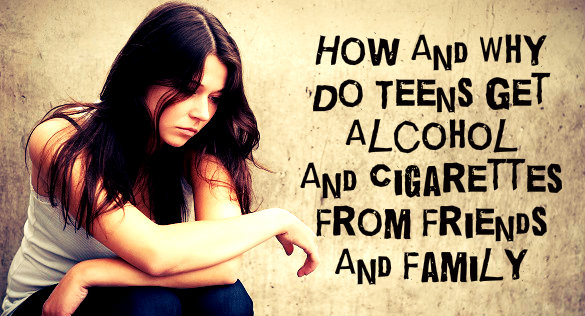
Gender, Age And Neighborhood Differences In Obtaining Cigarettes, Alcohol
Males were more likely to report that they had obtained cigarettes from a store compared with females. Seventy-three percent of the females involved in the survey said that their last cigarette came from a friend or family member.
When students were asked about consuming alcohol, 39 percent of those that drank said that their last drink was given to them, while 28 percent asked someone else to purchase the alcohol for them. Four percent of students said that they purchased the alcohol themselves from a liquor store.
The students from an urban area were more likely than those in rural settings to indicate that someone had provided them with alcohol (40 vs. 35 percent). Among those in rural areas, 33 percent of the students said that they gave someone else money to purchase alcohol for them, while 27 percent of students in urban settings asked someone to buy alcohol for them.
The report also found that there were trends according to the student’s age. Older teens were more likely than their younger counterparts to admit that they obtained alcohol by paying someone to purchase it for them. This occurred at a rate of 32 percent for older teens versus two percent for younger teens. Younger teens were more likely to indicate that someone gave them alcohol at a rate of 53 percent versus 37 percent for older teens.
Parents And Corner Stores Involvement And Responsibility
Principal investigator for the study, Dr. Robert Mann, is also the Senior Scientist at CAMH. Mann explained that teens are often obtaining alcohol and cigarettes from the very people that should be protecting them from exposure to such substances.
The findings also indicated that teens were able to easily access cigarettes from corner stores that don’t sell alcohol. The findings suggest that the availability of alcohol at corner stores could result in increasing rates of teens purchasing alcohol.
The information for the study was derived from the Ontario Student Drug Use and Health Survey by CAMH. The survey was administered to 9,288 students in the 7 through 12 grades at 40 public and Catholic schools in Ontario. The survey has been given to students every two years since 1977.
Parents concerned about their children obtaining alcohol and cigarettes during adolescence can openly discuss these matters with their teens. Studies have shown that by introducing the topic multiple times into conversation teens are much more able to make informed decisions.
Another way to prevent teens from using substances is to talk with other family members about the teens’ substance use. In some cases, the teen is obtaining cigarettes or alcohol from an older sibling.


